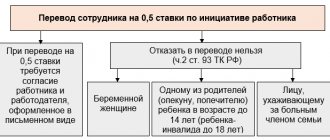Home / Labor Law / Employment / Part-time and part-time work
Back
Published: 08/07/2016
Reading time: 6 min
0
1746
Chapter 44 of the Labor Code of the Russian Federation, which includes seven articles - from 282 to 288, is devoted to the concept and rules for registering part-time work.
According to Article 282, part-time work is the regular performance by an employee of other work activities in his free time from his main job.
For this work activity, the employee receives monetary remuneration twice a month. To do this, he is obliged to fulfill all the conditions described in the employment contract.
- Full pay for a part-time worker
- Decor
- Payment
What is part-time work?
Part-time work is the performance by an employee of other paid regular work with the signing of an employment contract, during time free from work at the main place of employment.
This definition is very comprehensive and gives a clear idea of the conditions when work will not be considered part-time work.
Let's give examples.
| Example | Why is it not a part-time job? |
| 1. The girl officially works as a laboratory assistant at a research institute. On vacation he participates in the Greenpeace movement | For the second type of activity, the girl does not receive wages, and performing the second job on a paid basis is an indispensable condition. This is an example of volunteering |
| 2. The company’s accountant temporarily performs the functions of a cashier while the latter is on vacation | There is no regular nature of work. This is a combination |
| 3. An economist also performs the functions of a programmer within one eight-hour working day | The two jobs do not follow one another, but are performed in parallel. Here we are also talking about combining |
It is noteworthy that a part-time worker can have as many additional official jobs as he wishes. The law does not specify any limiting figure.
The only limiting factor is that there are only 24 hours in a day. The part-time worker is not obliged to notify the main employer about his subsequent employment. As for working hours, here, on the contrary, there is a limitation: the length of the working day at a non-main job must be within 4 hours daily.
Correct hiring
The future employee draws up an application for part-time employment, which must be signed by his director. The employment contract is standard, as when applying for the main job, but with an indication that the work is carried out on a part-time basis. Please note that if an employee applies for a job on a general basis without indicating that he is already officially working in another place, the contract may be invalidated.
The employment contract is standard, as when applying for the main job, but with an indication that the work is carried out on a part-time basis.
For internal combination, re-submission of your passport and training documents is not necessary. More often they do without a new employment contract by drawing up an additional agreement. This is possible if the combination occurs within the same profession. But a sales manager will not be able to add the functions of a courier driver if this is not in the list of job responsibilities.
Internal part-time work can be formalized either by a fixed-term or an open-ended contract.
Types of part-time jobs
For part-time work, you can accept both external and internal part-time workers.
Let's present their differences in the table.
| Type of part-time job | Internal | External |
| Employer | A person occupies a second position at his main place of work | The work is "on the side" |
| Design features | In the TD for non-core work, it is necessary to note that this is a part-time job | |
| — Registration of a new TD is mandatory; — Two personnel numbers are created; Of course, no personal documents are required, since all of them are already in the personnel department | — TD The employee presents: - Passport; — SNILS, INN; — Diploma (if qualifications are important); — Certificate about the nature of the main work (to make sure that the first one is not associated with harmful substances or hazardous conditions) | |
| All primary documents are prepared. In the employment order, in the personal card, a note is made about the part-time nature of the work | ||
| Example | A woman works as an accountant in a supermarket - this is her main occupation. A separate agreement was also concluded with her, which included a second position - cashier. In the afternoon she sits at the cash register in the shopping area | A pediatrician sees children at a children's clinic in the first half of the day, where he is officially employed and where his work record book is kept. In the afternoon, the doctor sees patients in a private clinic, where he is also officially employed |
Options
There are two types of part-time work: internal and external.
There are two types of part-time work: internal and external. In the first case, a specialist performs several types of activities at one enterprise, and for each area of work enters into a separate employment contract.
External part-time work is when a person performs additional work duties for another employer in his free time .
IMPORTANT! The number of employment contracts that a person can enter into in addition to the main employment contract is not limited by law. Each such document is independent and has legal force.
Part-time work has the following characteristics:
- The need to fulfill powers and duties under each concluded employment contract.
- Doing work in your free time.
- Regular nature of work.
- Receiving timely payment in the amount established by the employment contract.
When part-time work is prohibited
The law describes situations in which a person cannot have a second official job at the same time as the first:
- Minor age. This limitation is natural, because the law prescribes restrictions on the workload of persons under 18 years of age;
- Harmful or dangerous working conditions - at both jobs. For example, a man cannot work half a day as a fireman and half a day as a miner;
- Drivers of vehicles. The logic is that drivers are responsible for people's lives, and lack of rest will reduce the overall level of safety;
- Deputies of the State Duma of the Russian Federation cannot officially engage in work other than lawmaking. Exceptions: teaching or scientific activities;
- Heads of companies cannot simultaneously be members of internal control bodies. For example, the general director is also prohibited from serving on the audit committee;
- Managers cannot be part-time workers in other companies, unless they have received written consent from the owner of the enterprise;
- Employees of law enforcement agencies, employees of the Bank of Russia.
Can a part-time worker work full time?
As a general rule, the law does not allow this. From the logic of the concept itself it follows that additional labor should only “adjacent” to the main activity and occupy a limited number of hours.
This amount is specified in the labor code and is, as already mentioned, no more than 4 hours daily. For most categories of workers, full-time work means a 40-hour work week, a five-day week, with 8 hours of work daily. Thus, with an eight-hour working day, 4 hours will be half, that is, half the time.
There are a number of exceptions to this rule, where full-time part-time work is still permitted.
Exception for certain days
It is permissible to work all 8 hours, provided that the person’s main job has a day off, a day off or a vacation (the latter of the above - if the employee did not want to go on vacation for a non-main job) (Article 284 of the Labor Code). We are talking about specific days. Of course, if an employee spends 8 hours a day at a non-core job for a month or more, there is a violation of current legislation.
It is important to consider that the total number of hours worked per month at the second job should be half the monthly norm at the first job.
Example . Petrov works as a programmer; at his main place of work, his hourly rate for August 2021 was 184 hours. At his second job, where he holds a part-time position as an economist, according to the law, the hourly rate in August should not exceed 92 hours (184/2). At the beginning of August, at his first job, Petrov had five consecutive non-working days of 8 hours each (weekends plus days off) - that is, he worked there for a total of 40 hours. Consequently, this month, as a part-time worker, he has the right to work only 52 more hours, if we subtract the actually worked time from the allowed time (92-40).
Exceptions in which hour restrictions are completely removed
Sometimes an employee has the right not to take into account the hourly rate at his main place of work. Such full-time work is possible when he stops working at his main job.
The following situations are distinguished:
- The employee temporarily stopped working due to the fact that the main employer delayed payment of wages for more than half a month. In this case, the decision on suspension must be in writing;
- The part-time worker was temporarily suspended from his main job due to health reasons. The employee is required to provide a medical report as confirmation;
- A part-time worker falls into the category of “teachers” or “medical workers”. An exception applies if the municipality is in dire need of specialists in this field.
Features of the work of part-time employees
Part-time worker is a special category of workers. They work in addition to their main job in their free time. This right is written down in Article 60.1 of the Labor Code of the Russian Federation.
Relations in the sphere of labor of part-time workers are regulated by the Labor Code, article 284 of which states that a part-time worker can work no more than 20 hours a week . This value corresponds to half the rate and labor standard of ordinary workers. It turns out that if you divide all the maximum working hours of part-time workers throughout the week, then they must work 4 hours a day.
In practice, a part-time worker may work unevenly during the week or may not work at all every day.
Let's give an example. The employee worked 5 hours on Monday, and only 3 on Tuesday. The rest of the week, work was carried out for 4 hours.
The employment contract with a part-time worker must clearly state what part of the salary the employee is employed at, what schedule he will work on and how much he will receive for performing his duties.
| IMPORTANT! Whatever work schedule the employee chooses, in any case, he has no right to work part-time for more than 20 hours a week. |
Part-time worker's remuneration
A part-time employee should not receive less for any reason other than due to fewer hours worked. Any infringement of rights from the series “he is from the outside” is a gross violation of the Labor Code.
An employer can pay a part-time worker’s salary in two ways:
- By number of hours. The amount that an employee in this position should receive per hour according to the tariff schedule is multiplied by the number of hours worked.
- Based on the amount of work completed.
If an employee is very valuable and the employer seeks to reward him, it is possible to give him a bonus. The amount is at the discretion of the employer. The basis for bonuses may be extensive work experience or a high level of qualifications.
Types of shortened labor hours
The term “part-time” does not exist as such. This is the common name for shortened labor hours. The following types of part-time work are distinguished:
- Partial day. This is a situation when an employee, for some reason, works fewer hours than required by the standard.
- Shortened work week. An organization may have a work process that lasts 4 days a week. By the way, such an initiative has been actively discussed recently
- Mixed type. The employer may decide to work part time and not the whole week.
It should also be noted that the Labor Code does not have a clear standard for reduced time. In accordance with this, with part-time work, an employee can work 39 hours, or maybe 20 hours. This issue is regulated by the employer.
Part-time workers - personnel issues
In general, the law protects part-time workers in all aspects of their life at the enterprise.
- Vacation . A part-time worker has the right to go on leave from both jobs at the same time. This gives you the opportunity to take a break from both jobs at once. Employers cannot prevent this.
A part-time worker has the right to leave from a non-main job, even if he has not yet worked the required six months.
- Sick leave . In case of internal part-time work, the employee is required to submit only one sick leave certificate, in case of external part-time work – two. The second document notes that it is intended for part-time work and indicates the details of the main sick leave. Thus, each employer calculates and pays “its share” in proportion to the time worked;
- Business trips . As a general rule, an employer can send an employee on a work assignment at almost any time. In the case of part-time workers, there is a limitation - travel is possible only during time free from the main place of work.
- Dismissal . To dismiss a part-time employee, you can use the same grounds as for dismissing a main employee. As a general rule, a part-time employee cannot be fired if he is on maternity leave, on vacation or on sick leave.
Required documents for registration
To conclude a contract, you must provide the following list of documents:
- Passport or other identification document.
- SNILS.
- Education document. A diploma or certificate is required in cases where a person is applying for a position that requires special knowledge.
- A certificate containing information about the nature of the work performed at the main place (when employed in hazardous industries).
This list of documents is standard and enshrined in law. In some cases, employers may ask for any additional information when concluding an employment contract.
REFERENCE. It is not necessary to provide a work book to an external part-time worker . If an employee wishes to make a record of additional work activity in the document, this record is made on the basis of an existing order.










